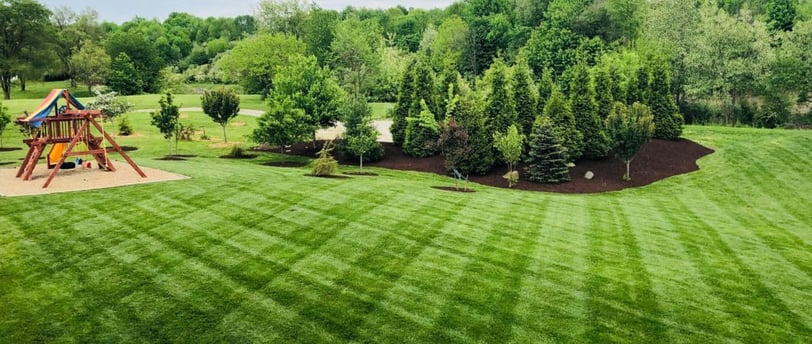The Ultimate Guide to Lawn Care
Tips for a Lush, Green Lawn
4/18/20244 min read


Taking care of your lawn might seem straightforward, but proper lawn care involves several essential practices that help create the lush, green yard you've always dreamed of. Not only does a well-maintained lawn enhance your home’s curb appeal, but it also provides a relaxing space for outdoor activities, promotes healthy soil, and boosts property value.
Understanding Your Lawn Type
To achieve a healthy lawn, it’s crucial to start by identifying the type of grass you have. Lawns typically consist of either warm-season or cool-season grasses, each requiring specific care routines. Warm-season grasses like Bermuda or Zoysia thrive in hot climates, while cool-season varieties, such as Kentucky Bluegrass, are better suited for cooler areas.
Preparing the Lawn for Success
Before diving into regular maintenance, invest time in preparing your lawn’s foundation. Testing your soil’s pH level is essential, as it determines which nutrients are available to your grass. Most lawns prefer a pH between 6.0 and 7.0. Additionally, choose a fertilizer that suits your lawn type, as this will ensure that your grass receives the nutrients it needs to grow strong.
Essential Lawn Care Tools
To maintain your lawn effectively, you’ll need a few essential tools. Basic equipment includes a sturdy lawn mower, a rake, and a watering can or sprinkler. For more advanced care, consider adding tools like an aerator and dethatcher to your collection.
Watering Techniques for Optimal Growth
Proper watering is key to healthy grass growth. Water your lawn deeply and infrequently, aiming to provide about 1 inch of water per week. Watering in the early morning is best, as it reduces evaporation and allows the lawn to absorb moisture efficiently.
The Importance of Mowing
Mowing may seem routine, but it’s crucial to cut your grass at the right height and frequency. Each grass type has an ideal height, so make sure you’re not cutting too short, as this can stress the grass and make it susceptible to weeds and diseases. Keep your mower blades sharp to ensure a clean cut.
Aeration: Letting Your Lawn Breathe
Aeration is the process of creating small holes in your lawn to allow air, water, and nutrients to penetrate deeper into the soil. Lawns generally benefit from aeration once a year, especially if the soil is compacted. The best times for aeration depend on the type of grass you have, with spring or fall typically being ideal.
Dethatching for a Healthier Lawn
Thatch is a layer of organic material that builds up between the soil and grass blades. A small amount of thatch is natural, but excessive buildup can block water and nutrients. If you notice a thick layer of thatch, consider dethatching your lawn to promote healthier growth.
Dealing with Weeds
Weeds compete with your grass for nutrients, sunlight, and water. To keep them under control, start with identifying common weeds in your area, such as dandelions and crabgrass, and use targeted methods for removal. Manual removal, proper mowing, and applying pre-emergent herbicides are effective strategies.
Fertilization Tips for a Thriving Lawn
Fertilization replenishes nutrients in the soil, supporting strong and vibrant grass growth. The best time to fertilize depends on your grass type, but most lawns benefit from fertilization in early spring and late fall. Opt for organic fertilizers if possible, as they’re kinder to the environment and improve soil health.
Pest Control and Lawn Protection
Insects like grubs and armyworms can damage your lawn by feeding on grass roots. To prevent pest infestations, encourage natural predators and avoid over-fertilization, which can attract pests. For a more eco-friendly approach, consider using neem oil or introducing beneficial insects.
Lawn Diseases: Identification and Treatment
Lawn diseases, such as brown patch or powdery mildew, can affect the appearance and health of your grass. It’s essential to recognize the signs early and apply appropriate treatments. For instance, proper watering and avoiding over-fertilization can help prevent many diseases.
Seasonal Lawn Care Tips
Lawn care changes with each season. In spring, focus on cleanup and aeration; in summer, emphasize regular watering and pest control. Fall is ideal for overseeding and fertilization, while winter requires minimal maintenance—just avoid heavy foot traffic on frozen lawns.
Sustainable Lawn Care Practices
For a healthier, eco-friendly lawn, try using native plants and grasses that require less water and fewer chemicals. Reducing chemical use not only benefits the environment but also encourages the growth of beneficial microorganisms in the soil.
Conclusion
Maintaining a beautiful lawn takes time and commitment, but the results are well worth it. By following these tips, you can create a lush, green oasis that will be the envy of the neighborhood. So, grab your tools, put in a little effort, and watch your lawn thrive!
FAQs
How often should I water my lawn?
Deeply water your lawn about once a week, aiming for 1 inch of water, depending on your climate and grass type.What’s the best mowing height for my lawn?
Each grass type has its ideal mowing height. Research your specific grass type to ensure you’re not cutting it too short.When is the best time to fertilize my lawn?
Early spring and late fall are generally ideal times, but this can vary depending on your grass type.How do I prevent weeds in my lawn?
Use pre-emergent herbicides, mow at the correct height, and water correctly to keep weeds under control.What is the purpose of aeration?
Aeration improves soil structure, allows better nutrient and water absorption, and reduces soil compaction.
